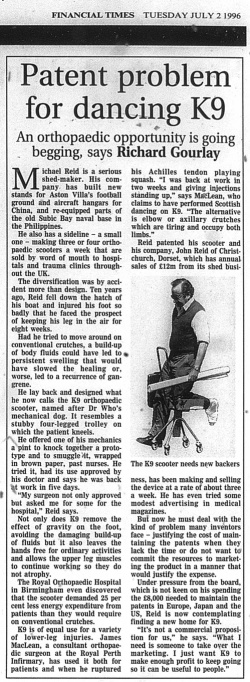Patent problem for dancing K9
- Publication: Financial Times
- Date: 1996-07-02
- Author: Richard Gourlay
- Page: 10
- Language: English
Michael Reid is a serious shed-maker. His company has built new stands for Aston Villa's football ground and aircraft hangars for China, and re-equipped parts of the old Subic Bay naval base in the Philippines.
He also has a sideline - a small one - making three or four orthopaedic scooters a week that are sold by word of mouth to hospitals and trauma clinics throughout the UK.
The diversification was by accident more than design. Ten years ago Reid fell down the hatch of his boat and injured his foot so badly that he faced the prospect of keeping his leg in the air for eight weeks.
Had he tried to move around on conventional crutches, a build-up of body fluids could have led to persistent swelling that would have slowed the healing or, worse, led to a recurrence of gangrene.
He lay back and designed what he now calls the K9 orthopaedic scooter, named after Dr Who's mechanical dog. It resembles a stubby four-legged trolley on which the patient kneels.
He offered one of his mechanics a pint to knock together a prototype and to smuggle it past nurses, wrapped in brown paper. He tried it, had its use approved by his doctor and says he was back at work in five days.
'My surgeon not only approved, but asked me for some for the hospital,' Reid says.
Not only does K9 remove the effect of gravity on the foot, avoiding the damaging build-up of fluids, but it also leaves the hands free for ordinary activities and allows the upper leg muscles to continue working so they do not atrophy.
The Royal Orthopaedic Hospital in Birmingham even discovered that the scooter demanded 25 per cent less energy expenditure from patients than they would require on conventional crutches.
K9 is of equal use for a variety of lower-leg injuries. James MacLean, a consultant orthopaedic surgeon at the Royal Perth Infirmary, has used it both for patients and when he ruptured his Achilles tendon playing squash. 'I was back at work in two weeks and giving injections standing up,' says MacLean, who claims to have performed Scottish dancing on K9. 'The alternative is elbow or axillary crutches which are tiring and occupy both limbs.'
Reid patented his scooter and his company, John Reid of Christchurch, Dorset, which has annual sales of Pounds 12m from its shed business, has been making and selling the device at a rate of about three a week. He has even tried some modest advertising in medical magazines.
But now he must deal with the kind of problem many inventors face - justifying the cost of maintaining the patents when they lack the time or do not want to commit the resources to marketing the product in a manner that would justify the expense.
Under pressure from the board, which is not keen on him spending the Pounds 8,000 needed to maintain the patents in Europe, Japan and the US, Reid is now contemplating finding a new home for K9.
'It's not a commercial proposition for us,' he says. 'What I need is someone to take over the marketing. I just want K9 to make enough profit to keep going so it can be useful to people.'
Disclaimer: These citations are created on-the-fly using primitive parsing techniques. You should double-check all citations. Send feedback to whovian@cuttingsarchive.org
- APA 6th ed.: Gourlay, Richard (1996-07-02). Patent problem for dancing K9. Financial Times p. 10.
- MLA 7th ed.: Gourlay, Richard. "Patent problem for dancing K9." Financial Times [add city] 1996-07-02, 10. Print.
- Chicago 15th ed.: Gourlay, Richard. "Patent problem for dancing K9." Financial Times, edition, sec., 1996-07-02
- Turabian: Gourlay, Richard. "Patent problem for dancing K9." Financial Times, 1996-07-02, section, 10 edition.
- Wikipedia (this article): <ref>{{cite news| title=Patent problem for dancing K9 | url=http://cuttingsarchive.org/index.php/Patent_problem_for_dancing_K9 | work=Financial Times | pages=10 | date=1996-07-02 | via=Doctor Who Cuttings Archive | accessdate=12 April 2025 }}</ref>
- Wikipedia (this page): <ref>{{cite web | title=Patent problem for dancing K9 | url=http://cuttingsarchive.org/index.php/Patent_problem_for_dancing_K9 | work=Doctor Who Cuttings Archive | accessdate=12 April 2025}}</ref>
